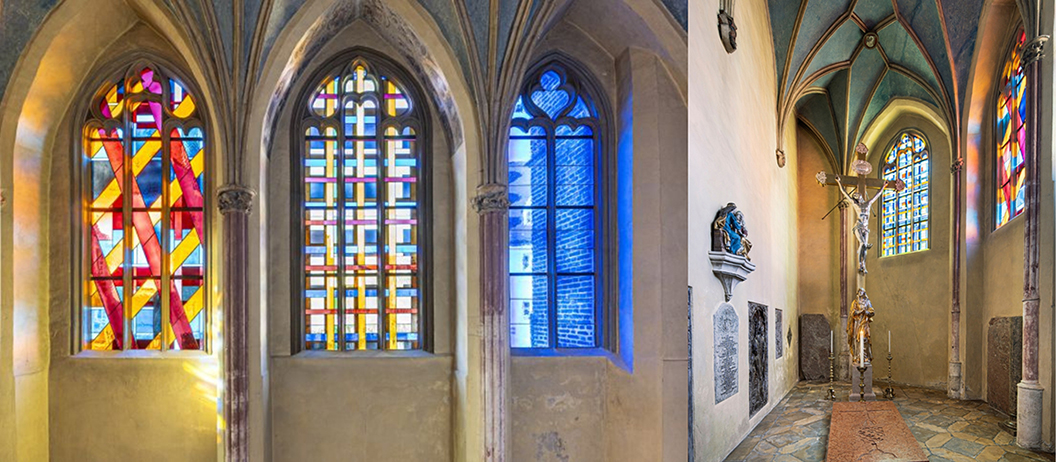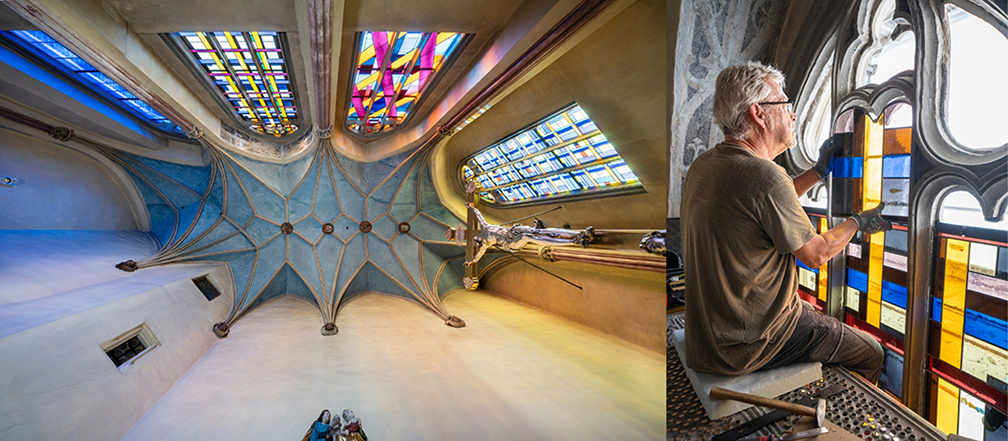Last Words: A Lenten Meditation on the Final Sayings of Christ, Week 4نموونە

Beholding the Strange Glory of the Crucified Christ



Scully Windows (four windows - three views), Sean Scully, 2024. Stained glass windows, Altdorf Chapel , Abbey Basilica of St. Martin, Landshut, Germany.
“Let All Mortal Flesh Keep Silent” from the album Till Morn Eternal Breaks. Performed by The Chamber Choir of St. Tikhon’s Monastery directed by Benedict Sheehan.
Poetry:
“A Geode”
by Robert B. Shaw
What started out a glob of molten mud
hawked up by some Brazilian volcano
back in the Pleistocene is now a rock
of unremarkable appearance, brown
as ordinary mud and baseball-size.
Picking it up produces a surprise:
besides a pleasant heftiness, a sound
of sloshing can be noticed. Vapors caught
within its cooling crust were liquified,
and linger still: a million-year-old vintage.
Although one might recall the once ubiquitous
snowstorm-in-a-glass-globe paperweights,
this offers us no view inside to gauge
the wild weather a shake or two incites.
Turbulence masked by hard opacity . . .
If we could, which would we rather see?—
age-old distillate, infant tears of the earth,
or gem-like crystal of the inner walls
harboring them like some fair reliquary?
To see the one we'd have to spill the other.
Better to keep it homely and intact,
a witness to the worth of hiddenness,
which, in regard to our own kind, we call
reticence, and in terms of higher things,
mystery. Let the elixir drench unseen
the facets that enshrine it, world without end.
BEHOLDING THE STRANGE GLORY OF THE CRUCIFIED CHRIST
If you get the chance to see sunlight spill through a stained glass window, take a moment to notice how the beauty is multifold. Not only does the window itself shine forth, but light also passes through to fall softly on the interior in vibrant colors, transforming walls or worshipers, pews or prayers. But to create this radiance, there is also a beauty to the brokenness these windows must hold: stained glass windows cast light through many pieces—cut, divided, broken—all arranged to create kaleidoscopic inspiration.
Yes, there is a glory to something that is broken, then remade. The prophet Haggai records, “The glory of this present house will be greater than the glory of the former house.” (Haggai 2:9, NIV). This touches on a paradox of our faith: our redemption lies in Christ's brokenness. But His brokenness alone does not suffice, it must be coupled with the Resurrection. Because without the Resurrection, Christ’s sacrifice would be like broken glass left only to pierce, reduced to a tragic, hopeless murder. So, to behold the strange glory of the crucified Christ is to confront the gore and horror of the Crucifixion while simultaneously beholding the beauty and joy of the Resurrection that left the tomb empty.
Today’s creative offerings invite deep reflection on this. Images of Sean Scully’s stained glass windows help us focus on the beauty of Christ crucified; their colorful light interacts with the silver crucifix, echoing the light of resurrection that lies outside the tomb. And each window symbolically speaks, from Mary's blue sorrow to the Church's multicolored joy. The hymn “Let All Mortal Flesh Keep Silent” also spans the life of Christ and connects to our focus in the lines, “as the Light of light descendeth from the realms of endless day, that the pow'rs of hell may vanish as the darkness clears away.” And the poem “A Geode” by Robert B. Shaw compellingly gives us insight into how amethysts inside a geode are only revealed through breaking. “To see the one we'd have to spill the other,” he writes. The Apostle Paul reinforces this reality: “And if Christ has not been raised, your faith is futile; you are still in your sins. [...] If only for this life we have hope in Christ, we are of all people most to be pitied. But Christ has indeed been raised from the dead.” (1 Corinthians 15:17, 19-20a, NIV).
How horrific and pitiful it must have been as Mary and John watched Jesus suffer and die. Yet while many abandoned him, their committed love allowed them to see him at his most paradoxically triumphant. They chose to behold him as he broke. That witness, if alone and final, would have left anyone in despair. This is why Mary and John's witness to the Resurrection is important. Their presence at both the laden cross and the empty tomb demonstrates the centrality of embracing both aspects of salvation in our faith. Their firsthand experience—“that which we have heard, which we have seen with our eyes, which we have looked upon, and our hands have handled”—makes this declaration, “we beheld His glory,” all the more powerful.
Still, there is much difficulty in this world for us to witness or experience. I know many people who have lost houses and neighborhoods in the recent LA fires. Other friends are fighting cancer. And I will share that it’s been difficult for me to hold space for my Christian brothers and sisters who have such extremely different and contentious political views. But, this past December, God invited me to a theme for 2024: “Behold the Lamb of God.” That focus led me to select this particular day of the Lent Project as the one I’d write on—to behold the crucified Christ. It is a focus that can be difficult. Growing up in evangelical Protestantism, the emphasis was mainly on hope or joy, often to the exclusion of balancing aspects like suffering and sacrifice, or the “with-ness” Jesus went through in his redemptive mission. His presence with us in our holistic lives is essential; it reminds us that in all, God can be present. Likewise, we must strive to be present for each other, to choose to behold Christ and each other in brokenness or repair.
It is in belonging to the Church, Jesus’ family, that we are called to realize the complete picture of Christ. As we behold the brokenness of this world, we behold the glory of Christ crucified and Christ resurrected. So, even in the pain of seeing a loved one succumb to disease, a neighborhood to fire, or our world to chaos, we can yet join with the ceaseless voices of heaven crying, “Alleluia, alleluia, alleluia, Lord Most High!”
Prayer: [If possible, face a source of light or warmth as you pray.]
Jesus, thank you for your sacrifice on the cross and triumph over the grave. Help me to be transformed by beholding you. And grant me the courage and compassion to behold others in the light of your Crucifixion and Resurrection.
Amen
Steven Homestead
Artist, Composer, Writer, and Curator
کتێبی پیرۆز
دەربارەی ئەم پلانە

The Lent Project is an initiative of Biola University's Center for Christianity, Culture and the Arts. Each daily devotion includes a portion of Scripture, a devotional, a prayer, a work of visual art or a video, a piece of music, and a poem plus brief commentaries on the artworks and artists. The Seven Last Words of Christ refers to the seven short phrases uttered by Jesus on the cross, as gathered from the four Christian gospels. This devotional project connects word, image, voice and song into daily meditations on these words.
More
پلانە پەیوەستەکان

Blindsided

The Intentional Husband: 7 Days to Transform Your Marriage From the Inside Out

Create: 3 Days of Faith Through Art

Healthy Friendships

Journey Through Leviticus Part 2 & Numbers Part 1

A Heart After God: Living From the Inside Out

The Revelation of Jesus

Wisdom for Work From Philippians

Unbroken Fellowship With the Father: A Study of Intimacy in John
